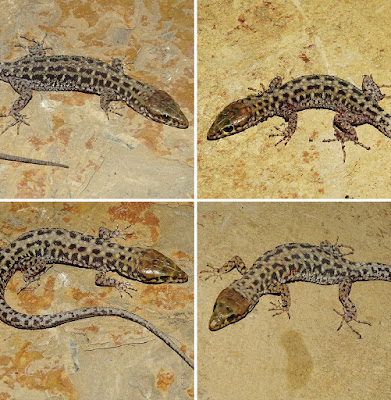 |
| Lepidophyma jasonjonesi Grünwald, Reyes-Velasco, Ahumada-Carrillo, Montaño-Ruvalcaba, Franz-Chávez, La Forest, Ramírez-Chaparro, Terán-Juárez & Borja-Jiménez, 2023 Jones’ Night Lizard | Lagartija Nocturna de Jones || DOI: 10.3897/herpetozoa.36.e96184 |
Abstract
We describe a new saxicolous species of Lepidophyma from the Sierra Madre Oriental, in the state of Tamaulipas, Mexico and provide morphological and molecular data to support the novelty of this species. The new species is most closely related to members of the L. sylvaticum group; however; it is a flattened form specialised for a saxicolous lifestyle and it can be distinguished from all other members by a combination of meristic characters. Genetic analysis suggests that several populations of L. sylvaticum might represent additional novel taxa, while the validity of L. micropholis is questioned. We discuss conservation priorities of the new species.
Key Words: conservation, night lizards, reptiles, Sierra Madre Oriental, systematics, taxonomy
Lepidophyma jasonjonesi sp. nov.
Proposed standard English name: Jones’ Night Lizard
Proposed standard Spanish name: Lagartija Nocturna de Jones
Diagnosis: Lepidophyma jasonjonesi sp. nov. can be distinguished from all its congeners by the following combination of characters: flattened head and body, head height 31–32% of head length; anterior pretympanic plate large, similar size as anterior supratemporal; 52–54 gular scales; 0–1 gular scales contacting first pair of infralabials; 180–182 dorsal scales mid-ventrally between occipitals and rump; 17–18 enlarged tubercles in paravertebral row between axilla and groin, 16 enlarged tubercles in second vertebral row between axilla and groin; 37–40 total femoral pores; 27–30 lamellae on fourth toe of foot, with 10–15 divided mid-ventrally; 35–38 ventral scale rows, with 10 longitudinal ventral scale rows; iris brown.
 |
| (A–D) Variation of Lepidophyma jasonjonesi sp. nov. individuals seen at the type locality. All photographs by Jason M. Jones, taken in October, 2016. |
 |
| Photo of the locality and habitat at the type locality of Lepidophyma jasonjonesi sp. nov. (Photo from Google Earth). |
Christoph I. Grünwald, Jacobo Reyes-Velasco, Iván T. Ahumada-Carrillo, Carlos Montaño-Ruvalcaba, Héctor Franz-Chávez, Brandon T. La Forest, Ricardo Ramírez-Chaparro, Sergio Terán-Juárez and Juan Miguel Borja-Jiménez. 2023. A New Species of saxicolous Lepidophyma (Squamata, Xantusiidae) from Tamaulipas, Mexico. Herpetozoa. 36: 9-21. DOI: 10.3897/herpetozoa.36.e96184
Resumen: Describimos una nueva especie saxícola de Lepidophyma de la Sierra Madre Oriental, en el estado de Tamaulipas, México, y proporcionamos datos morfológicos y moleculares para apoyar la validez de esta especie. La nueva especie está más estrechamente relacionada con los miembros del grupo L. sylvaticum, sin embargo es de un morfotipo aplanado especializado para una vida saxícola y se puede distinguir de todos los demás miembros por una combinación de caracteres merísticos. Los análisis genéticos sugieren que varias poblaciones de L. sylvaticum podrían representar nuevos taxones adicionales, mientras que se cuestiona la validez de L. micropholis. Se discuten las prioridades de conservación de la nueva especie.
Palabras Clave: conservación, Lagartijas Nocturnas, Reptiles, Sistemática, Taxonomía
Kurzfassung: Wir beschreiben eine neue Felsen bewohnende Art von Lepidophyma aus der Sierra Madre Oriental im Bundesstaat Tamaulipas (Mexiko) und legen morphologische und molekulare Daten vor, die die Hypothese, dass es sich um eine neue Art handelt, unterstützen. Die neue Art ist am nächsten mit der L. sylvaticum-Gruppe verwandt, hat jedoch eine abgeflachte Morphologie, die zeigt, dass sie auf Felsen spezialisiert ist. Sie lässt sich durch einer Kombination meristischer Merkmale von allen anderen Mitgliedern der Gattung unterscheiden. Genetische Analysen deuten an, dass mehrere Populationen von L. sylvaticum weitere neue Arten darstellen könnten, während die Gültigkeit von L. micropholis in Frage gestellt wird. Wir empfehlen Prioritäten für den Schutz der neuen Art.
Schlüsselwörter: Nachteidechsen, Naturschutz, Reptilien, Sierra Madre Oriental, Systematik, Taxonomie



